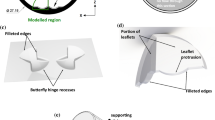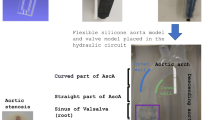Abstract
Point-wise velocity measurements have been traditionally acquired to estimate blood damage potential induced by prosthetic heart valves with emphasis on peak values of velocity magnitude and Reynolds stresses. However, the inherently Lagrangian nature of platelet activation and hemolysis makes such measurements of limited predictive value. This study provides a refined fluid mechanical analysis, including blood element paths and stress exposure times, of the hinge flows of a CarboMedics bileaflet mechanical heart valve placed under both mitral and aortic conditions and a St Jude Medical bileaflet valve placed under aortic conditions. The hinge area was partitioned into characteristic regions based on dominant flow structures and spatio-temporal averaging was performed on the measured velocities and Reynolds shear stresses to estimate the average bulk stresses acting on blood elements transiting through the hinge. A first-order estimate of viscous stress levels and exposure times were computed. Both forward and leakage flow phases were characterized in each partition by dynamic flows dependent on subtle leaflet movements and transvalvular pressure fluctuations. Blood elements trapped in recirculation regions may experience exposure times as long as the entire forward flow phase duration. Most calculated stresses were below the accepted blood damage threshold. Estimates of the stress levels indicate that the flow conditions within the boundary layers near the hinge and leaflet walls may be more detrimental to blood cells than bulk flow conditions, while recirculation regions may promote thrombus buildup.









Similar content being viewed by others
References
Anderson G. H., et al. (1978) Platelet lysis and aggregation in shear fields. Blood Cells 4(3):499–511
Bacher R. P., M. C. Williams (1970) Hemolysis in capillary flow. J. Lab. Clin. Med. 76(3):485–496
Belval T. K., J. D. Hellums (1986) Analysis of shear-induced platelet aggregation with population balance mathematics. Biophys. J. 50(3):479–487
Bernstein E. F., U. Marzec, G. G. Johnston (1977) Structural correlates of platelets functional damage by physical forces. Trans. Am. Soc. Artif. Intern. Organs 23:617–625
Blackshear P. L., et al. (1966) Shear wall interaction and hemolysis. ASAIO J. 12:113–120
Blackshear P. L. (1972) Hemolysis at prosthetic surfaces. In: Hair M. R. (ed.) Chemistry of Biosurface. Marcel Dekker, New York, pp. 523–62
Blackshear, P. L. Mechanical hemolysis in flowing blood. In: Biomechanics: Its Foundation and Objectives, edited by Y.C. Fung, N. Perrone, and M. Anliker. Englewood Cliffs, NJ: P. Hall, pp. 501–525, 1972
Brown C. H., et al. (1975) Morphological, biochemical, and functional changes in human platelets subjected to shear stress. J. Lab. Clin. Med. 3:462–474
Brown C. H., et al. (1975) Response of human platelets to shear stress. Trans. Am. Soc.Artif. Intern. Organs 21:35–38
Ellis J., et al. (1996) Velocity measurements and flow patterns within the hinge region of a Medtronic Parallel bileaflet mechanical heart valve with clear housing. J. Heart Valve Dis. 5(6):591–599
Ellis J. T., B. R. Travis, A. P. Yoganathan (2000) An in vitro study of the hinge and near-field forward flow dynamics of the St. Jude Medical® Regent™ bileaflet mechanical heart valve. Ann. Biomed. Eng. 28:524–532
Forstrom R. J. (1969) A New Measure of Erythrocyte Membrane Strength. University of Minnesota, Minneapolis
Grigioni M., et al. (1999) A discussion on the threshold limit for hemolysis related to Reynolds shear stress. J. Biomech. 32(10):1107–1112
Grigioni M., et al. (2004) The power-law mathematical model for blood damage prediction: analytical developments and physical inconsistencies. Artif. Organs 28(5):467–475
Gross J. M., et al. (1996) A microstructural flow analysis within a bileaflet mechanical heart valve hinge. J. Heart Valve Dis. 5(6):581–590
Hellums, J. D., and C. H. I. Brown. Blood cell damage by mechanical forces. In: Cardiovascular Flow Dynamics and Measurements, edited by N. H. C. Hwang, and N. A. Normann. Baltimore: University Park Press, 1977, pp. 799–822
Indeglia R. A., et al. (1968) Influence of mechanical forces on erythrocyte sublethal damage. Trans. Am. Soc. Artif. Intern. Organs 14:264
Keshaviah, J. M. S. Thesis. University of Minnesota, Minneapolis, 1970
Leo H.-L., et al. (2002) Microflow fields in the hinge region of the CarboMedics bileaflet mechanical heart valve design. J. Thoracic Cardiovas. Surg. 124(3):561–574
Leo H.-L. (2005) An in vitro Investigation of the Flow Fields Through Bileaflet and Polymeric Prosthetic Heart Valves, in Biomedical Engineering Department. Georgia Institute of Technology, Atlanta
Leverett L. B., et al. (1972) Red blood cell damage by shear stress. Biophys. J. 12:257–273
Lu P. C., H. C. Lai, J. S. Liu (2001) A reevaluation and discussion on the threshold limit for hemolysis in a turbulent shear flow. J. Biomech. 34:1361–1364
Nevaril, C. G., et al. Erythrocyte damage and destruction induced by shearing stress. J. Lab. Clin. Med. 71:784, 1968
Rooney J. A. (1970) Hemolysis near an ultrasonically pulsating gas bubble. Science 169(948):869–871
Sallam A. M., N. H. C. Hwang (1984) Human red blood cell hemolysis in a turbulent shear flow: contribution of Reynolds shear stresses. Biorheology 21:783–797
Simon H. A., et al. (2004) Comparison of the hinge flow fields of two bileaflet mechanical heart valves under aortic and mitral conditions. Ann. Biomed. Eng. 32(12):1607–1617
Simon H. S. (2004) Influence of the Implant Location on the Hinge and Leakage Flow Fields Through Bileaflet Mechanical Heart Valves, in Chemical and Biomolecular Engineering Department. Georgia Institute of Technology, Atlanta
Slack S. M., Y. Cui, V. T. Turitto (1993) The effects of flow on blood coagulation and thrombosis. Thromb Haemostasis 70(1):129–134
Slack S. M., L. K. Jennings, V. T. Turitto (1994) Platelet-size distribution measurements as indicators of shear stres-induced platelet aggregation. Ann Biomed Eng 22:653–659
Sutera S. P., P. Croce, M. H. Mehrjardi (1972) Hemolysis and subhemolytic alterations of human RBC induced by turbulent shear flow. ASAIO Trans. 18:335–341
Sutera S. P., M. H. Mehrjardi (1975) Deformation and fragmentation of human red blood cells in turbulent shear flow. Biophys. J. 15:1–10
Williams, A. R. Shear-induced fragmentation of human erythrocytes. Biorheology 10:303–311, 1972
Williams A. R., D. E. Hughes, W. L. Nyborg (1970) Hemolysis near a transversely oscillating wire. Science 169(948):871–873
Wurzinger L. J., et al. (1985) Platelet and coagulation parameters following millisecond exposure to laminar shear stress. Thromb Haemostasis 54:381–386
Wurzinger L. J., et al. (1985) “Shear induced platelet activation”—a critical reappraisal. Biorheology 22(5):399–413
Wurzinger L. J., P. Blasberg, H. Schmid-Schonbein (1985) Towards a concept of thrombosis in accelerated flow: rheology, fluid dynamics, and biochemistry. Biorheology 22:437–449
Wurzinger L. J., R. Opitz, H. Eckstein (1986) Mechanical blood trauma: an overview. Angeiologie 38:81–97
Acknowledgments
The authors gratefully acknowledge the financial support from the National Heart, Lung and Blood Institute (RO1-HL-07262) and from Tom and Shirley Gurley.
Author information
Authors and Affiliations
Corresponding author
Rights and permissions
About this article
Cite this article
Simon, H.A., Dasi, L.P., Leo, HL. et al. Spatio-temporal Flow Analysis in Bileaflet Heart Valve Hinge Regions: Potential Analysis for Blood Element Damage. Ann Biomed Eng 35, 1333–1346 (2007). https://doi.org/10.1007/s10439-007-9302-1
Received:
Accepted:
Published:
Issue Date:
DOI: https://doi.org/10.1007/s10439-007-9302-1




